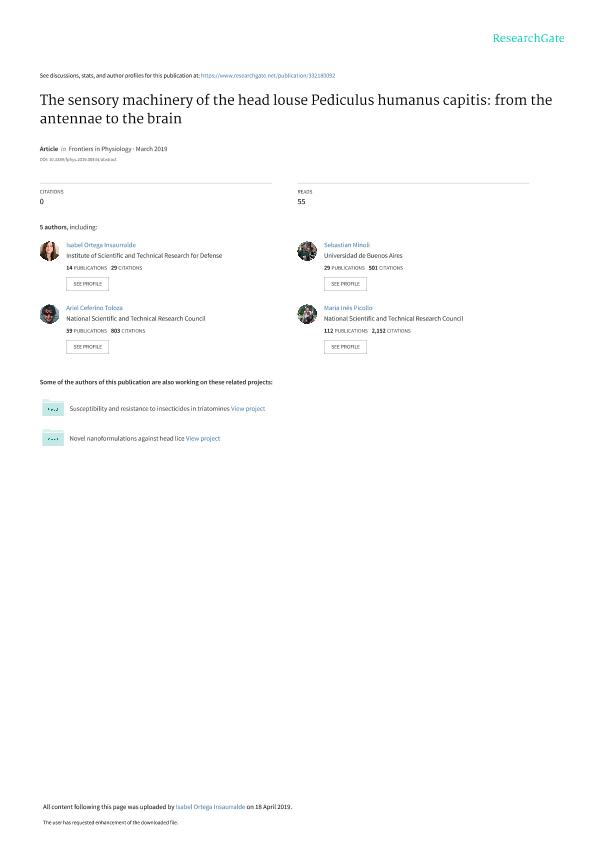Mostrar el registro sencillo del ítem
dc.contributor.author
Ortega Insaurralde, Isabel

dc.contributor.author
Minoli, Sebastian Antonio

dc.contributor.author
Toloza, Ariel Ceferino

dc.contributor.author
Picollo, Maria Ines

dc.contributor.author
Barrozo, Romina

dc.date.available
2020-11-07T02:48:48Z
dc.date.issued
2019-05
dc.identifier.citation
Ortega Insaurralde, Isabel; Minoli, Sebastian Antonio; Toloza, Ariel Ceferino; Picollo, Maria Ines; Barrozo, Romina; The sensory machinery of the head louse pediculus humanus capitis: From the antennae to the brain; Frontiers Media S.A.; Frontiers in Physiology; 10; 434; 5-2019; 1-12
dc.identifier.issn
1664-042X
dc.identifier.uri
http://hdl.handle.net/11336/117874
dc.description.abstract
Insect antennae are sophisticated sensory organs, usually covered with sensory structures responsible for the detection of relevant signals of different modalities coming from the environment. Despite the relevance of the head louse Pediculus humanus capitis as a human parasite, the role of its antennal sensory system in the highly dependent relation established with their hosts has been barely studied. In this work, we present a functional description of the antennae of these hematophagous insects by applying different approaches, including scanning electron microscopy (SEM), anterograde antennal fluorescent backfills, and behavioral experiments with intact or differentially antennectomized lice. Results constitute a first approach to identify and describe the head louse antennal sensilla and to determine the role of the antenna in host recognition. SEM images allowed us to identify a total of 35–40 sensilla belonging to seven different morphological types that according to their external architecture are candidates to bear mechano-, thermo-, hygro-, or chemo-receptor functions. The anterograde backfills revealed a direct neural pathway to the ipsilateral antennal lobe, which includes 8–10 glomerular-like diffuse structures. In the two-choice behavioral experiments, intact lice chose scalp chemicals and warm surfaces (i.e., 32°C) and avoided wet substrates. Behavioral preferences disappeared after ablation of the different flagellomeres of their antenna, allowing us to discuss about the location and function of the different identified sensilla. This is the first study that integrates morphological and behavioral aspects of the sensory machinery of head lice involved in host perception.
dc.format
application/pdf
dc.language.iso
eng
dc.publisher
Frontiers Media S.A.

dc.rights
info:eu-repo/semantics/openAccess
dc.rights.uri
https://creativecommons.org/licenses/by-nc-sa/2.5/ar/
dc.subject
ANTENNAL LOBE
dc.subject
BEHAVIOR
dc.subject
HEAD LOUSE
dc.subject
HOST PERCEPTION
dc.subject
PEDICULUS HUMANUS CAPITIS
dc.subject
SENSILLA
dc.subject.classification
Zoología, Ornitología, Entomología, Etología

dc.subject.classification
Ciencias Biológicas

dc.subject.classification
CIENCIAS NATURALES Y EXACTAS

dc.title
The sensory machinery of the head louse pediculus humanus capitis: From the antennae to the brain
dc.type
info:eu-repo/semantics/article
dc.type
info:ar-repo/semantics/artículo
dc.type
info:eu-repo/semantics/publishedVersion
dc.date.updated
2020-10-22T18:24:50Z
dc.journal.volume
10
dc.journal.number
434
dc.journal.pagination
1-12
dc.journal.pais
Estados Unidos

dc.journal.ciudad
Columbus
dc.description.fil
Fil: Ortega Insaurralde, Isabel. Consejo Nacional de Investigaciones Científicas y Técnicas. Instituto de Investigaciones Científicas y Técnicas para la Defensa. Centro de Investigación de Plagas e Insecticidas; Argentina
dc.description.fil
Fil: Minoli, Sebastian Antonio. Consejo Nacional de Investigaciones Científicas y Técnicas. Oficina de Coordinación Administrativa Ciudad Universitaria. Instituto de Biodiversidad y Biología Experimental y Aplicada. Universidad de Buenos Aires. Facultad de Ciencias Exactas y Naturales. Instituto de Biodiversidad y Biología Experimental y Aplicada; Argentina
dc.description.fil
Fil: Toloza, Ariel Ceferino. Consejo Nacional de Investigaciones Científicas y Técnicas. Instituto de Investigaciones Científicas y Técnicas para la Defensa. Centro de Investigación de Plagas e Insecticidas; Argentina
dc.description.fil
Fil: Picollo, Maria Ines. Consejo Nacional de Investigaciones Científicas y Técnicas. Instituto de Investigaciones Científicas y Técnicas para la Defensa. Centro de Investigación de Plagas e Insecticidas; Argentina
dc.description.fil
Fil: Barrozo, Romina. Consejo Nacional de Investigaciones Científicas y Técnicas. Oficina de Coordinación Administrativa Ciudad Universitaria. Instituto de Biodiversidad y Biología Experimental y Aplicada. Universidad de Buenos Aires. Facultad de Ciencias Exactas y Naturales. Instituto de Biodiversidad y Biología Experimental y Aplicada; Argentina
dc.journal.title
Frontiers in Physiology
dc.relation.alternativeid
info:eu-repo/semantics/altIdentifier/url/https://www.frontiersin.org/article/10.3389/fphys.2019.00434/full
dc.relation.alternativeid
info:eu-repo/semantics/altIdentifier/doi/https://doi.org/10.3389/fphys.2019.00434
Archivos asociados
